-
- bimba
- Universal Robots
- dorner
- cobots
- industrial automation nj/ny
- The Knotts Company
- manufacturing
- Dorner Conveyors,
- The Knotts Co
- UR
- Robots
- PLC
- Unitronics
- automation
- humphrey products
- knotts company
- solutions
- HMI
- automation solutions
- cobot
- conveyors
- robotics
- aluminum extrusion
- aluminum extrusion in nj
- engineered solutions
- Robotiq
- air cylinder
- collaborative robots
- cost effective
- cost savings
- t-slotted extrusion
- bimba solutions
- collaborative robot
- technology
- MiR
- Humphrey
- IAI
- WAGO
- assembly
- bimba pneumatic
- machine guard
- smartflex conveyors
- solution
- 2200 Series
- cylinder
- electric cylinder
- motion control
- packaging
- pharmaceuticals
- sanitary conveyor
- Products
- automated palletizing
- automation control
- conveyor
- core competencies
- grippers
- palletizing
- resource
- robot
- AquaPruf
- Asycube
- Asyril
- Belt Conveyors
- Cage Clamp
- Food
- Machine Guarding
- Mobile Robots
- Norgren
- OptoForce
- Pneumadyne
- Pneumatic Valve
- ROBO Cylinder
- UR5
- actuators
- compressed air
- custom solution
- food safety and sanitation
- mobile industrial robot
- quality assurance
- robotics solutions
- safety
- stainless steel conveyors
- vision
- Belts
- Benefits
- Beverage
- Bimba IntelliSense®
- CT Effects
- PLC+HMI
- Proportion Air
- Proportional valve
- Questions
- Success
- UR10
- Vaccon
- automated inspection
- gripper
- improvement
- industrial vision
- intelligent actuator
- labeling application
- labor shortage
- life science
- medical
- medical industry
- pneumatic motion control
- sales process
- sensor
- thomas
- valve
- 3200 series
- 6-axis robot
- 80/20
- Acro
- Automate
- LMI
- Machine
- OnRobot
- Original Line Cylinder
- Pinch Valve
- Precision Technology
- Predictive Maintenance
- Preventive Maintenance
- Product News
- ROBO Cylinders
- ROI
- Reducing Costs
- automated mobile robot
- autonomous mobile robot
- connectors
- controls
- covid
- custom solutions
- customer service
- e-Series
- electric actuator
- electro-mechanical
- end of arm tools
- energy plant
- ethercat
- external resource
- flexmove technology
- guarding
- inspection
- machine control
- manufacturers
- monitoring
- motion
- new product
- outsource
- outsourcing
- packing
- pneumatic actuator
- pneumatic valves
- precision move
- quick response solution
- regulator
- sales tools
- steel frame
- vacuum
- vacuum technology
- welded steel frame
- 7X Series Conveyor
- AMR
- Advantages
- Application
- Applied Motion Products
- Asycube 530
- Asyfeed Pocket
- Balanced Valves
- CNC program
- Continuity Inspection Tool
- Control Panel
- Controllers
- Crowned Pulley
- F22 Series
- Factory Improved Productivity
- Filtration
- Fire Fighting
- Flexible Feed
- Freeze protection
- Gas
- High Pressure Regulator
- IP65
- Inspekto
- IntelliPress
- Intellisense
- International Manufacturing Technology Show 2016
- LARGO A5
- Legos
- MIRAI
- Machine Controllers
- Machine Vision
- Micropsi
- NJ
- NY
- New
- New Scale Robotics
- OEE
- Oil
- Optimization
- PACK EXPO
- PC10
- Parison Blow Molding
- Pick-it
- ProControl Series
- ROEQ
- Rain Test
- Resin Block
- Rio Olympics
- SCHUNK
- Sanitation
- Sensors
- Smart Manufacturing
- Spot Welding
- TRD
- Temperature Controller
- Training
- Trio Manufacturing Technology
- Twist Clamp
- UR3
- UniStream
- Universal
- V-guide
- Valve Assemble
- Vane-Buster
- Versagrip
- Versagrip solenoid pinch valves
- Victory Actuator
- Vision430
- XTR Series
- Yamaha
- balanced solenoid valve series
- bimba electric
- bottle filling
- brewery
- brushless motor
- buna
- center point
- chicane
- cloud
- cobot compliance
- collaborative operation
- compact series
- composite cylinder
- conference
- cost
- date code
- demonstration
- desiccant drier
Get the latest in your inbox.
This post is brought to you by Universal Robots.
The best automation solutions are smart, simple, innovative, and fully leverage technology to create significant business efficiencies and provide great benefits to employees and customers.
Today, Universal Robots collaborative robotic arms are being used to solve business problems with creative concepts and innovative solutions that can be integrated into all types and sizes of production.
Collaborative robots – cobots, are lightweight and compact, making the process of deploying and redeploying cobots to different tasks very convenient. There is often no need for additional safety equipment (subject to risk assessment) and combined with an intuitive programming interface, a simple pick and place task can be set up and implemented in less than one hour. However, not every business needs a straightforward pick and place application like this. If your production is more complex in nature, there are steps you can take to ensure your automation solution is flexible, collaborative and affordable.
Flexibility
Many companies run small batch productions with ever changing requirements, and it’s these companies that can greatly benefit from the flexibility of deploying cobots. A relatively low initial investment and rapid return on investment are critical for an SME to make the decision to implement the first robots into their facility.
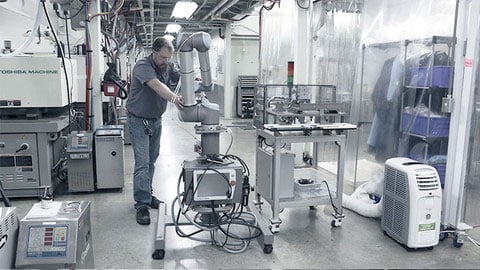
- Minimize customized fixed machinery & traditional automation
If the proposed solution includes a large amount of inflexible automation in order to complete the task, and the robot only constitutes a very small part of the overall solution, many of the key benefits of a collaborative robot can be lost. The one-time engineering costs for designing all of the additional equipment will be very high, and if you decide to redeploy the robot, it is often not possible to repurpose this fixed machinery. In many instances, this isn’t the most cost-effective solution for a business.
- Low cost vision systems add flexibility
Instead of designing a complex feeder system to align incoming products, a low-cost vision solution can allow the robot to identify any changes in position and orientation of products to be picked. If they’re implemented well, they won’t result in any reduction in reliability for the system. Modern integrated smart cameras are available for a very affordable price and are easy to integrate, increasing the capabilities of the robot. A vision system can also be redeployed just as easily as the robot to its next task.
- An adaptive gripper is a good investment
While a simple pneumatic chuck may do the job for a current application and cost a little less, additional costs will be incurred if the robot is redeployed, either in designing/producing new jaws or purchasing a new end-effector as the original is not suitable for new tasks. Pneumatics also add complexity to the system with additional components and the requirement for an air supply to be accessible wherever the robot is deployed. By selecting an adaptive gripper the robot can handle a wide range of products, and with many grippers, be controlled in either position or force mode for handling of products with uncertain shapes/sizes.
Collaboration
When it comes to space, cost and scope of applications, cobots have a big advantage because they can operate without safety fencing (subject to risk assessment) and work alongside workers safely. This opens up new application possibilities, where people aren’t just allowed, they are required to be in the robot workspace.
- Active collaborative applications
While in many cases a robot takes over a repetitive task from a worker allowing them to focus on more engaging work, it’s also increasingly common to have a robot working directly alongside a skilled worker on a complex task to increase their productivity. Where it is not possible to completely automate a task, the robot can be used as a smart tool to assist the worker, with increased product output and quality; this can still be a financially viable option. In certain artisanal industries, having the worker involved can retain individuality and increase the value of the product.
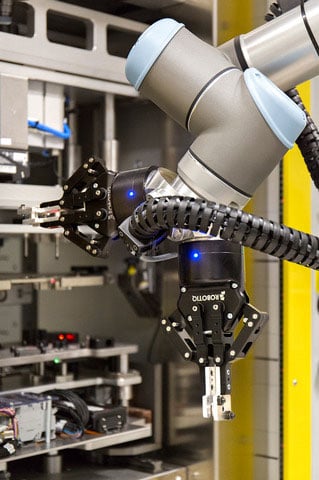
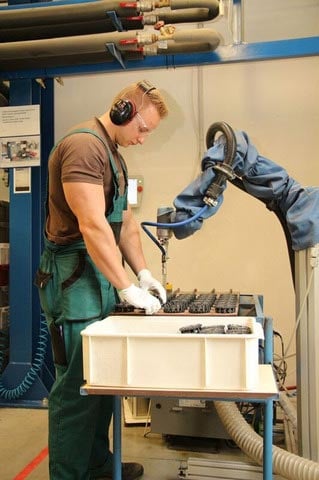
- Understanding safety
A comprehensive understanding of the robots, the safety system, and risks are essential for the success of the deployment.
Easy programming of smart applications
The Polyscope programming environment is very easy to learn, and also offers some very useful advanced features to allow for rapid and efficient programming of new applications.
- Rapid prototyping
If you can create a program on your cobot in as little as 20 minutes, why wait 10 days for something to be fabricated by an external supplier? Time and cost investment is greatly reduced if you do it yourself, giving your designers and engineers the freedom to try out their ideas without consequences.
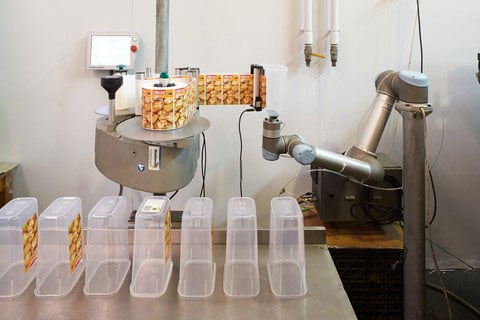
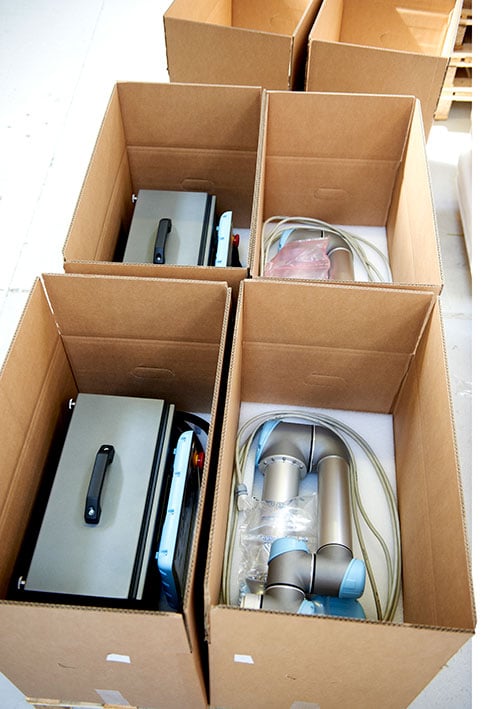 Multi-staged applications
Multi-staged applications
If a single robot can handle multiple stages of a process, the return on investment for the customer will obviously be even more attractive. For example, a robot in a plastic injection molding plant can apply labels to containers before packing them into boxes for shipping. A robot in consumer electronics factory can place multiple components into a plastic casing before screwing them into place and closing the casing.
- Out of the box solutions
The fewer non-recurring engineering hours that go into a solution, the greater the savings for the customer, with an entirely out of the box solution that can be replicated for multiple customers being the ultimate goal. While two projects will rarely be exactly the same, it’s a good idea to implement a solution so that as much of the work is reusable as possible. Writing the robot program in a modular manner makes a big difference when it comes to reusability. Splitting an application into sub-programs for sub-tasks within the program makes it easy to drop them straight into your next project.
Companies around the world have implemented smart applications using a collaborative automation solution.
Interested in an Universal Robot?
Interested in Learning More?
Please fill out our contact form, and a member of the Knotts Team will get in touch to help you.
%202.png?width=323&height=215&name=PH_VA_VR_Series_Technical_Support%20(1)%202.png)



